Comprehensive Report on Entrepreneurship and Small Business Ventures
VerifiedAdded on 2023/01/09
|20
|2835
|24
Report
AI Summary
This report provides a comprehensive overview of entrepreneurship and small business management, exploring various entrepreneurial ventures such as small business entrepreneurship, scalable startup entrepreneurship, large company entrepreneurship, and social entrepreneurship. It examines the similarities and differences between these ventures, providing insights into their characteristics and approaches. The report then assesses the impact of micro and small businesses on the economy, analyzing their contribution to GDP, revenue growth, employment, innovation, skill enhancement, and the fostering of entrepreneurship. It also highlights the importance of small businesses and business start-ups to the growth of the social economy, including their roles in employment, innovation, engaging people, promoting diversity, meeting social purposes, driving local improvement, and reducing socio-economic disparity. Finally, the report delves into the key aspects of the entrepreneurial mindset and explores the environments which can foster or hinder entrepreneurship.

Entrepreneurship and
Small Business
Management
Small Business
Management
Paraphrase This Document
Need a fresh take? Get an instant paraphrase of this document with our AI Paraphraser

Contents
Contents...........................................................................................................................................2
INTRODUCTION...........................................................................................................................1
TASK 1............................................................................................................................................1
P1: Entrepreneurial Ventures.......................................................................................................1
P2: Similarities and Differences between entrepreneurial ventures............................................2
TASK 2............................................................................................................................................4
P3: Interpretation and assessment of the impact of micro and small businesses on the economy
.....................................................................................................................................................4
P4: Importance of small businesses and business start-ups.........................................................6
Brochure..........................................................................................................................................8
CONCLUSION..............................................................................................................................16
REFERENCES..............................................................................................................................18
Contents...........................................................................................................................................2
INTRODUCTION...........................................................................................................................1
TASK 1............................................................................................................................................1
P1: Entrepreneurial Ventures.......................................................................................................1
P2: Similarities and Differences between entrepreneurial ventures............................................2
TASK 2............................................................................................................................................4
P3: Interpretation and assessment of the impact of micro and small businesses on the economy
.....................................................................................................................................................4
P4: Importance of small businesses and business start-ups.........................................................6
Brochure..........................................................................................................................................8
CONCLUSION..............................................................................................................................16
REFERENCES..............................................................................................................................18
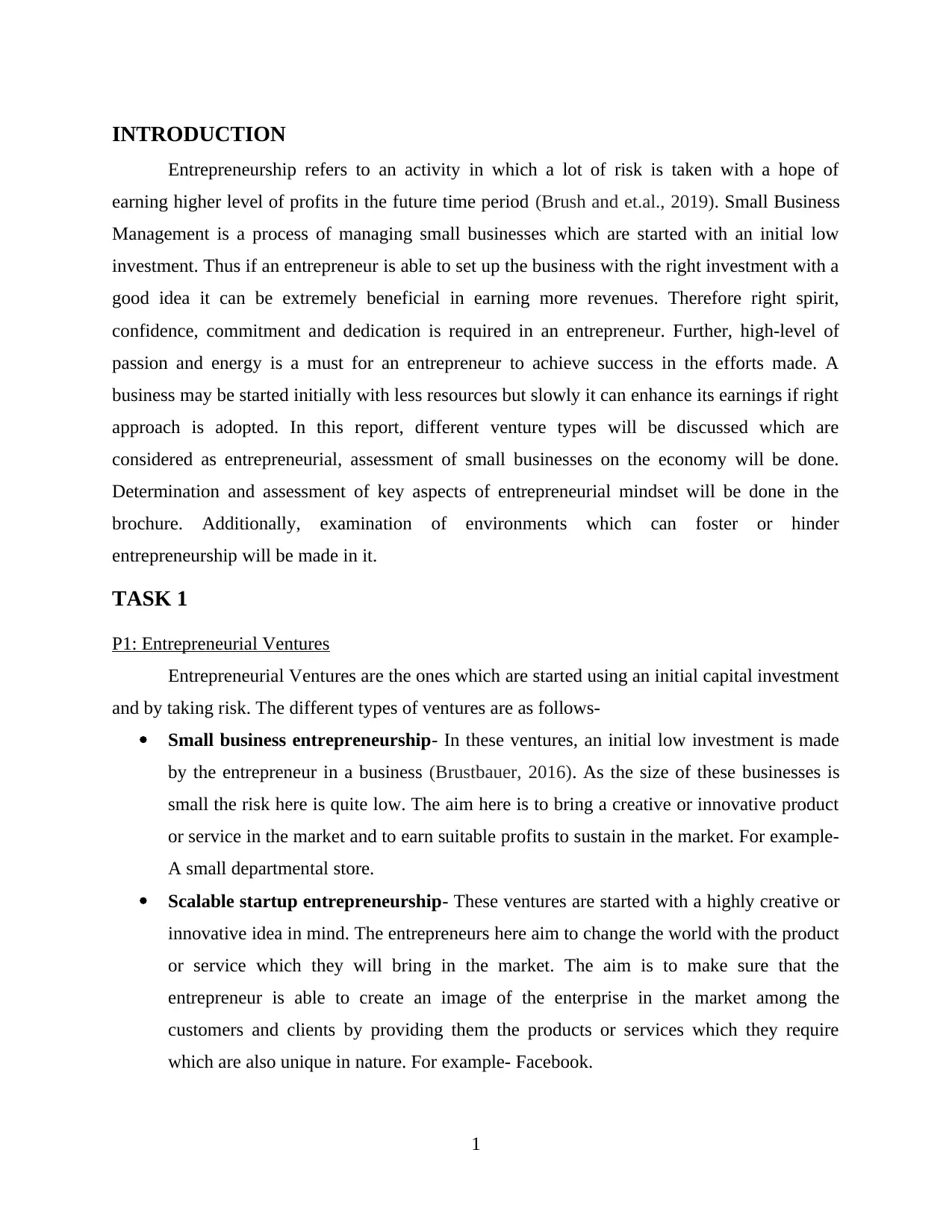
INTRODUCTION
Entrepreneurship refers to an activity in which a lot of risk is taken with a hope of
earning higher level of profits in the future time period (Brush and et.al., 2019). Small Business
Management is a process of managing small businesses which are started with an initial low
investment. Thus if an entrepreneur is able to set up the business with the right investment with a
good idea it can be extremely beneficial in earning more revenues. Therefore right spirit,
confidence, commitment and dedication is required in an entrepreneur. Further, high-level of
passion and energy is a must for an entrepreneur to achieve success in the efforts made. A
business may be started initially with less resources but slowly it can enhance its earnings if right
approach is adopted. In this report, different venture types will be discussed which are
considered as entrepreneurial, assessment of small businesses on the economy will be done.
Determination and assessment of key aspects of entrepreneurial mindset will be done in the
brochure. Additionally, examination of environments which can foster or hinder
entrepreneurship will be made in it.
TASK 1
P1: Entrepreneurial Ventures
Entrepreneurial Ventures are the ones which are started using an initial capital investment
and by taking risk. The different types of ventures are as follows-
Small business entrepreneurship- In these ventures, an initial low investment is made
by the entrepreneur in a business (Brustbauer, 2016). As the size of these businesses is
small the risk here is quite low. The aim here is to bring a creative or innovative product
or service in the market and to earn suitable profits to sustain in the market. For example-
A small departmental store.
Scalable startup entrepreneurship- These ventures are started with a highly creative or
innovative idea in mind. The entrepreneurs here aim to change the world with the product
or service which they will bring in the market. The aim is to make sure that the
entrepreneur is able to create an image of the enterprise in the market among the
customers and clients by providing them the products or services which they require
which are also unique in nature. For example- Facebook.
1
Entrepreneurship refers to an activity in which a lot of risk is taken with a hope of
earning higher level of profits in the future time period (Brush and et.al., 2019). Small Business
Management is a process of managing small businesses which are started with an initial low
investment. Thus if an entrepreneur is able to set up the business with the right investment with a
good idea it can be extremely beneficial in earning more revenues. Therefore right spirit,
confidence, commitment and dedication is required in an entrepreneur. Further, high-level of
passion and energy is a must for an entrepreneur to achieve success in the efforts made. A
business may be started initially with less resources but slowly it can enhance its earnings if right
approach is adopted. In this report, different venture types will be discussed which are
considered as entrepreneurial, assessment of small businesses on the economy will be done.
Determination and assessment of key aspects of entrepreneurial mindset will be done in the
brochure. Additionally, examination of environments which can foster or hinder
entrepreneurship will be made in it.
TASK 1
P1: Entrepreneurial Ventures
Entrepreneurial Ventures are the ones which are started using an initial capital investment
and by taking risk. The different types of ventures are as follows-
Small business entrepreneurship- In these ventures, an initial low investment is made
by the entrepreneur in a business (Brustbauer, 2016). As the size of these businesses is
small the risk here is quite low. The aim here is to bring a creative or innovative product
or service in the market and to earn suitable profits to sustain in the market. For example-
A small departmental store.
Scalable startup entrepreneurship- These ventures are started with a highly creative or
innovative idea in mind. The entrepreneurs here aim to change the world with the product
or service which they will bring in the market. The aim is to make sure that the
entrepreneur is able to create an image of the enterprise in the market among the
customers and clients by providing them the products or services which they require
which are also unique in nature. For example- Facebook.
1
⊘ This is a preview!⊘
Do you want full access?
Subscribe today to unlock all pages.

Trusted by 1+ million students worldwide
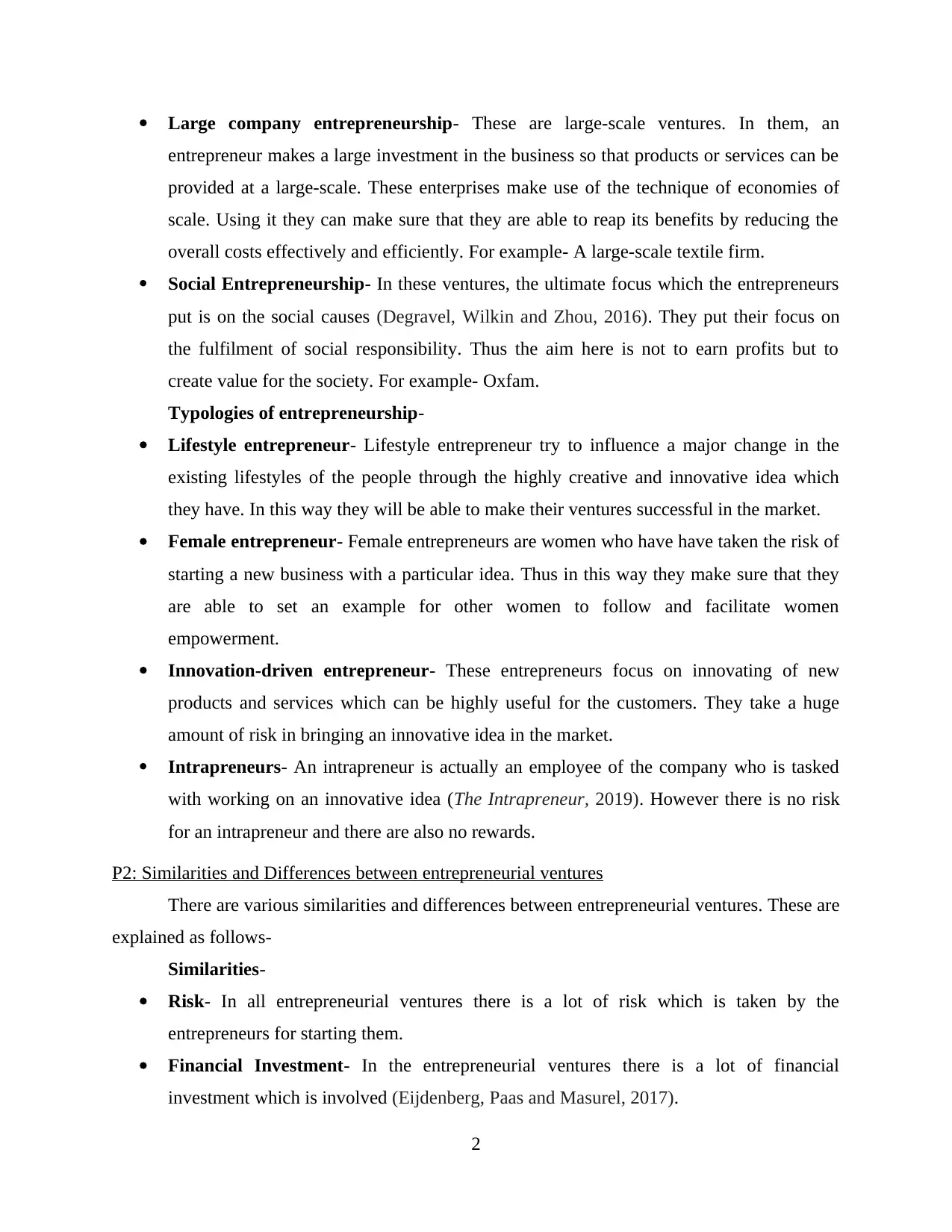
Large company entrepreneurship- These are large-scale ventures. In them, an
entrepreneur makes a large investment in the business so that products or services can be
provided at a large-scale. These enterprises make use of the technique of economies of
scale. Using it they can make sure that they are able to reap its benefits by reducing the
overall costs effectively and efficiently. For example- A large-scale textile firm.
Social Entrepreneurship- In these ventures, the ultimate focus which the entrepreneurs
put is on the social causes (Degravel, Wilkin and Zhou, 2016). They put their focus on
the fulfilment of social responsibility. Thus the aim here is not to earn profits but to
create value for the society. For example- Oxfam.
Typologies of entrepreneurship-
Lifestyle entrepreneur- Lifestyle entrepreneur try to influence a major change in the
existing lifestyles of the people through the highly creative and innovative idea which
they have. In this way they will be able to make their ventures successful in the market.
Female entrepreneur- Female entrepreneurs are women who have have taken the risk of
starting a new business with a particular idea. Thus in this way they make sure that they
are able to set an example for other women to follow and facilitate women
empowerment.
Innovation-driven entrepreneur- These entrepreneurs focus on innovating of new
products and services which can be highly useful for the customers. They take a huge
amount of risk in bringing an innovative idea in the market.
Intrapreneurs- An intrapreneur is actually an employee of the company who is tasked
with working on an innovative idea (The Intrapreneur, 2019). However there is no risk
for an intrapreneur and there are also no rewards.
P2: Similarities and Differences between entrepreneurial ventures
There are various similarities and differences between entrepreneurial ventures. These are
explained as follows-
Similarities-
Risk- In all entrepreneurial ventures there is a lot of risk which is taken by the
entrepreneurs for starting them.
Financial Investment- In the entrepreneurial ventures there is a lot of financial
investment which is involved (Eijdenberg, Paas and Masurel, 2017).
2
entrepreneur makes a large investment in the business so that products or services can be
provided at a large-scale. These enterprises make use of the technique of economies of
scale. Using it they can make sure that they are able to reap its benefits by reducing the
overall costs effectively and efficiently. For example- A large-scale textile firm.
Social Entrepreneurship- In these ventures, the ultimate focus which the entrepreneurs
put is on the social causes (Degravel, Wilkin and Zhou, 2016). They put their focus on
the fulfilment of social responsibility. Thus the aim here is not to earn profits but to
create value for the society. For example- Oxfam.
Typologies of entrepreneurship-
Lifestyle entrepreneur- Lifestyle entrepreneur try to influence a major change in the
existing lifestyles of the people through the highly creative and innovative idea which
they have. In this way they will be able to make their ventures successful in the market.
Female entrepreneur- Female entrepreneurs are women who have have taken the risk of
starting a new business with a particular idea. Thus in this way they make sure that they
are able to set an example for other women to follow and facilitate women
empowerment.
Innovation-driven entrepreneur- These entrepreneurs focus on innovating of new
products and services which can be highly useful for the customers. They take a huge
amount of risk in bringing an innovative idea in the market.
Intrapreneurs- An intrapreneur is actually an employee of the company who is tasked
with working on an innovative idea (The Intrapreneur, 2019). However there is no risk
for an intrapreneur and there are also no rewards.
P2: Similarities and Differences between entrepreneurial ventures
There are various similarities and differences between entrepreneurial ventures. These are
explained as follows-
Similarities-
Risk- In all entrepreneurial ventures there is a lot of risk which is taken by the
entrepreneurs for starting them.
Financial Investment- In the entrepreneurial ventures there is a lot of financial
investment which is involved (Eijdenberg, Paas and Masurel, 2017).
2
Paraphrase This Document
Need a fresh take? Get an instant paraphrase of this document with our AI Paraphraser

Creativity- In the entrepreneurial ventures there is a creative approach which the
entrepreneurs are required to undertake.
Innovation- Entrepreneurial ventures require the entrepreneurs to take an innovative
approach towards setting up a business.
Differences between entrepreneurial ventures-
Basis Small business
entrepreneurshi
p
Scalable startup
entrepreneurshi
p
Large company
entrepreneurshi
p
Social
entrepreneurshi
p
Size The size of these
businesses is
small.
These businesses
can be small or
large in the size.
These businesses
are set-up on a
large-scale.
These enterprises
can be small-scale
or large-scale.
Initial
investment
The initial
investment done
here is quite low
and the business
can be started
with low funds as
there are
comparatively
less financial
requirements.
The initial
investment which
is made here is
quite higher
because of the
amount which is
required to bring
a new idea into
existence.
Here, the large-
scale
entrepreneurship
is initiated using
the higher level of
initial investment
as the activities
here are carried
on a large level.
In these
enterprises the
initial investment
required may be
low because they
mostly indulge in
voluntary
activities and
provide social
service.
Risk The level of risk
which is involved
here is low
because of the
small size of the
enterprise.
The risk involved
here is high
because here a
completely new
idea is being
brought into
existence.
The risk here is
very high because
the business
activities are
carried on a large-
scale here and
there is a high
amount of
financial
The risk here is
very low because
these businesses
do not operate for
earning profits
but rather aim to
serve the society
by providing
value to it.
3
entrepreneurs are required to undertake.
Innovation- Entrepreneurial ventures require the entrepreneurs to take an innovative
approach towards setting up a business.
Differences between entrepreneurial ventures-
Basis Small business
entrepreneurshi
p
Scalable startup
entrepreneurshi
p
Large company
entrepreneurshi
p
Social
entrepreneurshi
p
Size The size of these
businesses is
small.
These businesses
can be small or
large in the size.
These businesses
are set-up on a
large-scale.
These enterprises
can be small-scale
or large-scale.
Initial
investment
The initial
investment done
here is quite low
and the business
can be started
with low funds as
there are
comparatively
less financial
requirements.
The initial
investment which
is made here is
quite higher
because of the
amount which is
required to bring
a new idea into
existence.
Here, the large-
scale
entrepreneurship
is initiated using
the higher level of
initial investment
as the activities
here are carried
on a large level.
In these
enterprises the
initial investment
required may be
low because they
mostly indulge in
voluntary
activities and
provide social
service.
Risk The level of risk
which is involved
here is low
because of the
small size of the
enterprise.
The risk involved
here is high
because here a
completely new
idea is being
brought into
existence.
The risk here is
very high because
the business
activities are
carried on a large-
scale here and
there is a high
amount of
financial
The risk here is
very low because
these businesses
do not operate for
earning profits
but rather aim to
serve the society
by providing
value to it.
3
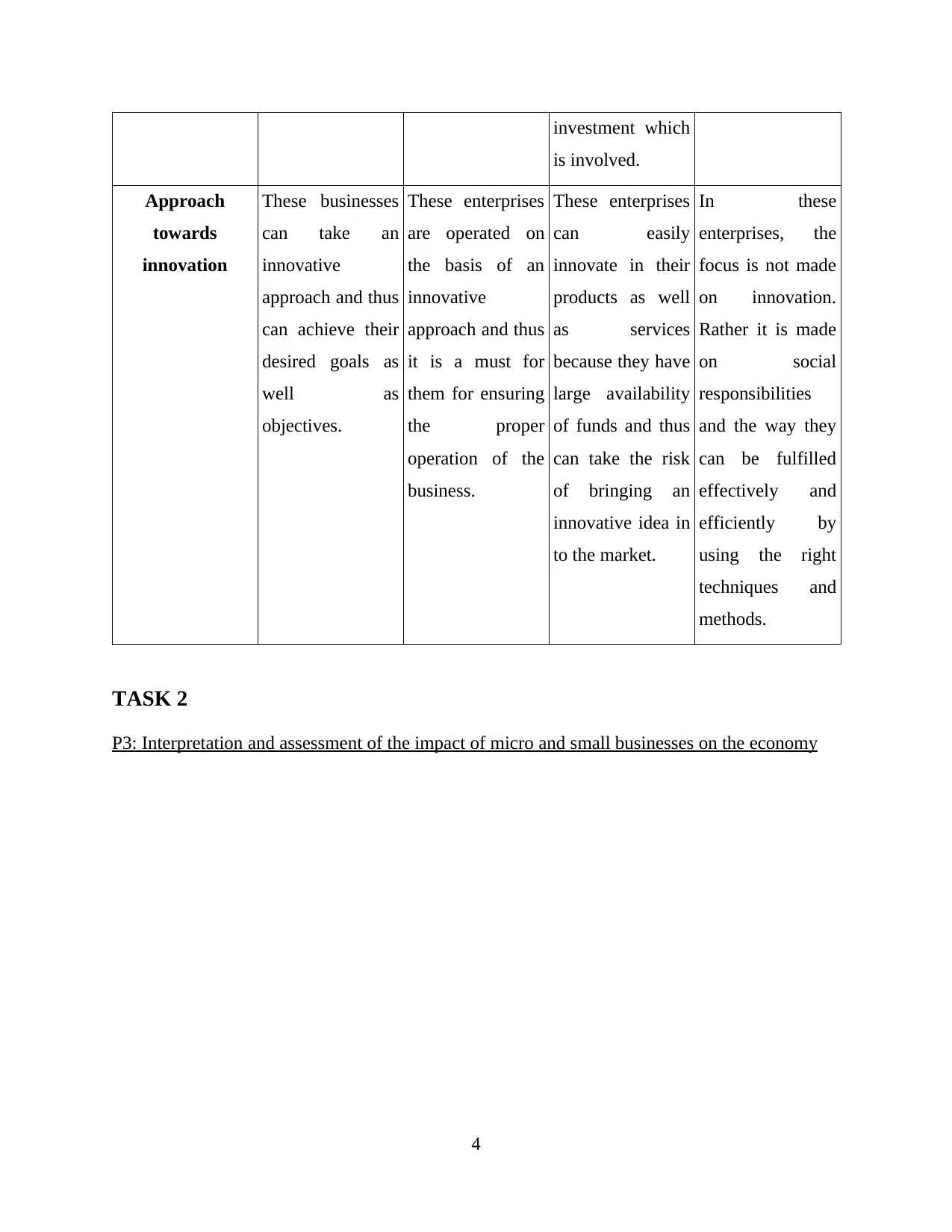
investment which
is involved.
Approach
towards
innovation
These businesses
can take an
innovative
approach and thus
can achieve their
desired goals as
well as
objectives.
These enterprises
are operated on
the basis of an
innovative
approach and thus
it is a must for
them for ensuring
the proper
operation of the
business.
These enterprises
can easily
innovate in their
products as well
as services
because they have
large availability
of funds and thus
can take the risk
of bringing an
innovative idea in
to the market.
In these
enterprises, the
focus is not made
on innovation.
Rather it is made
on social
responsibilities
and the way they
can be fulfilled
effectively and
efficiently by
using the right
techniques and
methods.
TASK 2
P3: Interpretation and assessment of the impact of micro and small businesses on the economy
4
is involved.
Approach
towards
innovation
These businesses
can take an
innovative
approach and thus
can achieve their
desired goals as
well as
objectives.
These enterprises
are operated on
the basis of an
innovative
approach and thus
it is a must for
them for ensuring
the proper
operation of the
business.
These enterprises
can easily
innovate in their
products as well
as services
because they have
large availability
of funds and thus
can take the risk
of bringing an
innovative idea in
to the market.
In these
enterprises, the
focus is not made
on innovation.
Rather it is made
on social
responsibilities
and the way they
can be fulfilled
effectively and
efficiently by
using the right
techniques and
methods.
TASK 2
P3: Interpretation and assessment of the impact of micro and small businesses on the economy
4
⊘ This is a preview!⊘
Do you want full access?
Subscribe today to unlock all pages.

Trusted by 1+ million students worldwide
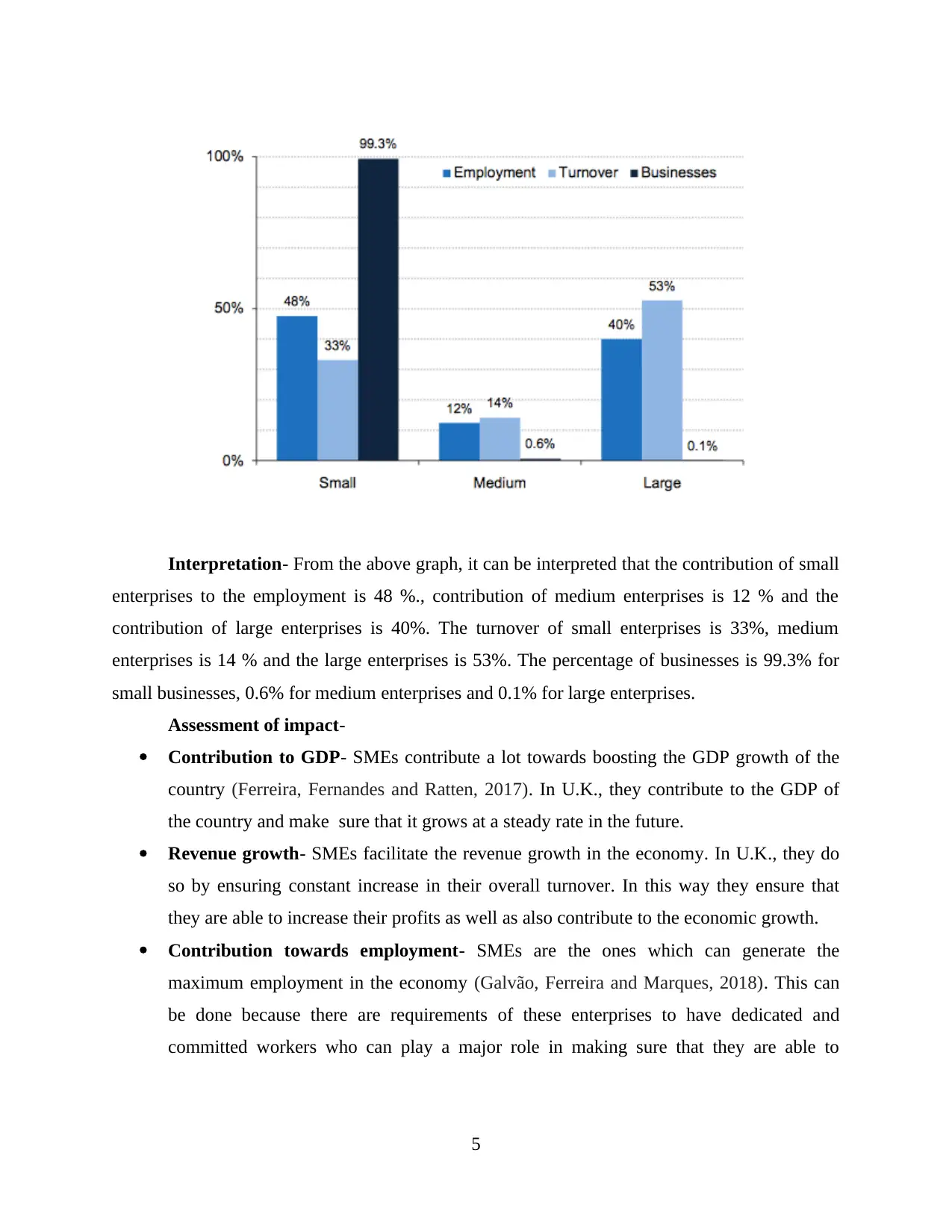
Interpretation- From the above graph, it can be interpreted that the contribution of small
enterprises to the employment is 48 %., contribution of medium enterprises is 12 % and the
contribution of large enterprises is 40%. The turnover of small enterprises is 33%, medium
enterprises is 14 % and the large enterprises is 53%. The percentage of businesses is 99.3% for
small businesses, 0.6% for medium enterprises and 0.1% for large enterprises.
Assessment of impact-
Contribution to GDP- SMEs contribute a lot towards boosting the GDP growth of the
country (Ferreira, Fernandes and Ratten, 2017). In U.K., they contribute to the GDP of
the country and make sure that it grows at a steady rate in the future.
Revenue growth- SMEs facilitate the revenue growth in the economy. In U.K., they do
so by ensuring constant increase in their overall turnover. In this way they ensure that
they are able to increase their profits as well as also contribute to the economic growth.
Contribution towards employment- SMEs are the ones which can generate the
maximum employment in the economy (Galvão, Ferreira and Marques, 2018). This can
be done because there are requirements of these enterprises to have dedicated and
committed workers who can play a major role in making sure that they are able to
5
enterprises to the employment is 48 %., contribution of medium enterprises is 12 % and the
contribution of large enterprises is 40%. The turnover of small enterprises is 33%, medium
enterprises is 14 % and the large enterprises is 53%. The percentage of businesses is 99.3% for
small businesses, 0.6% for medium enterprises and 0.1% for large enterprises.
Assessment of impact-
Contribution to GDP- SMEs contribute a lot towards boosting the GDP growth of the
country (Ferreira, Fernandes and Ratten, 2017). In U.K., they contribute to the GDP of
the country and make sure that it grows at a steady rate in the future.
Revenue growth- SMEs facilitate the revenue growth in the economy. In U.K., they do
so by ensuring constant increase in their overall turnover. In this way they ensure that
they are able to increase their profits as well as also contribute to the economic growth.
Contribution towards employment- SMEs are the ones which can generate the
maximum employment in the economy (Galvão, Ferreira and Marques, 2018). This can
be done because there are requirements of these enterprises to have dedicated and
committed workers who can play a major role in making sure that they are able to
5
Paraphrase This Document
Need a fresh take? Get an instant paraphrase of this document with our AI Paraphraser
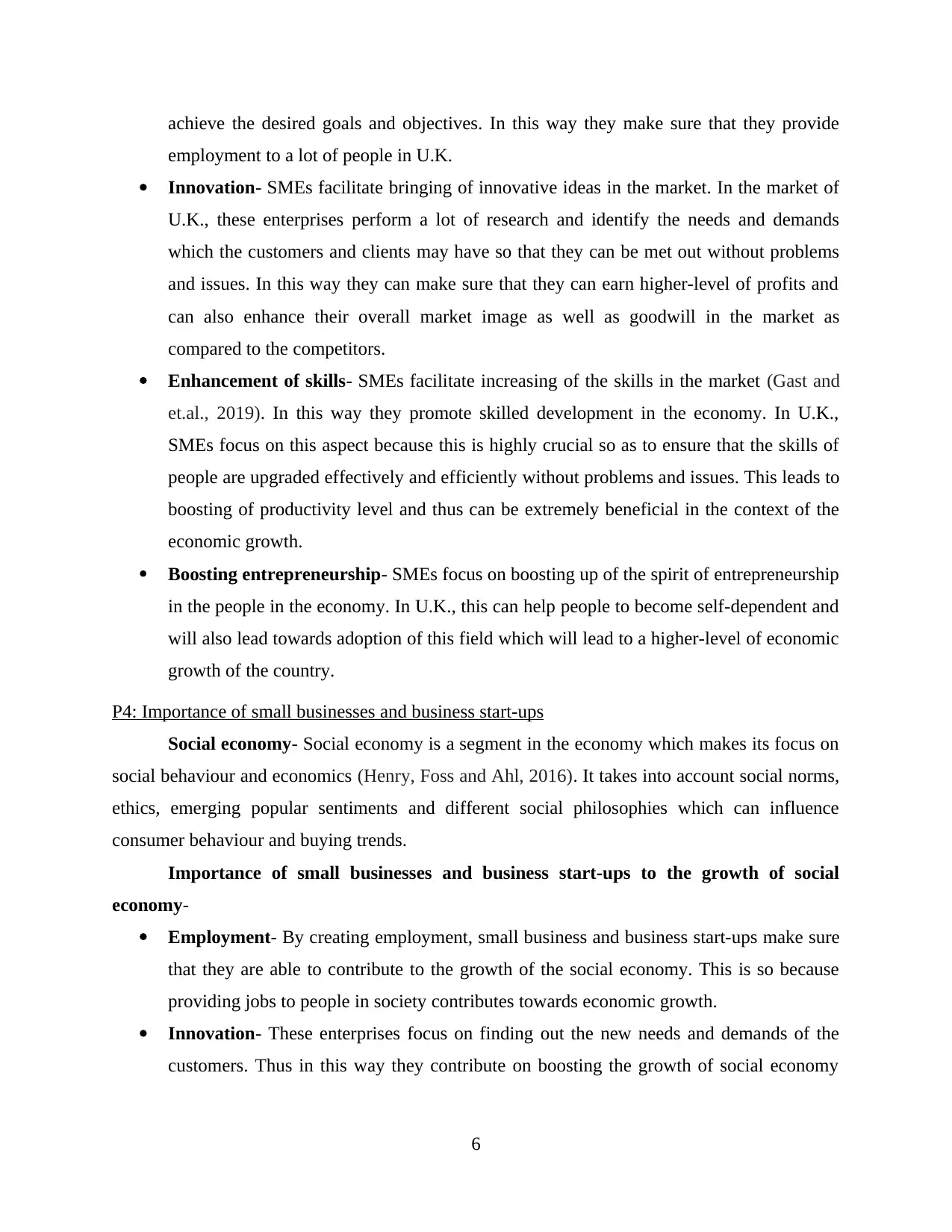
achieve the desired goals and objectives. In this way they make sure that they provide
employment to a lot of people in U.K.
Innovation- SMEs facilitate bringing of innovative ideas in the market. In the market of
U.K., these enterprises perform a lot of research and identify the needs and demands
which the customers and clients may have so that they can be met out without problems
and issues. In this way they can make sure that they can earn higher-level of profits and
can also enhance their overall market image as well as goodwill in the market as
compared to the competitors.
Enhancement of skills- SMEs facilitate increasing of the skills in the market (Gast and
et.al., 2019). In this way they promote skilled development in the economy. In U.K.,
SMEs focus on this aspect because this is highly crucial so as to ensure that the skills of
people are upgraded effectively and efficiently without problems and issues. This leads to
boosting of productivity level and thus can be extremely beneficial in the context of the
economic growth.
Boosting entrepreneurship- SMEs focus on boosting up of the spirit of entrepreneurship
in the people in the economy. In U.K., this can help people to become self-dependent and
will also lead towards adoption of this field which will lead to a higher-level of economic
growth of the country.
P4: Importance of small businesses and business start-ups
Social economy- Social economy is a segment in the economy which makes its focus on
social behaviour and economics (Henry, Foss and Ahl, 2016). It takes into account social norms,
ethics, emerging popular sentiments and different social philosophies which can influence
consumer behaviour and buying trends.
Importance of small businesses and business start-ups to the growth of social
economy-
Employment- By creating employment, small business and business start-ups make sure
that they are able to contribute to the growth of the social economy. This is so because
providing jobs to people in society contributes towards economic growth.
Innovation- These enterprises focus on finding out the new needs and demands of the
customers. Thus in this way they contribute on boosting the growth of social economy
6
employment to a lot of people in U.K.
Innovation- SMEs facilitate bringing of innovative ideas in the market. In the market of
U.K., these enterprises perform a lot of research and identify the needs and demands
which the customers and clients may have so that they can be met out without problems
and issues. In this way they can make sure that they can earn higher-level of profits and
can also enhance their overall market image as well as goodwill in the market as
compared to the competitors.
Enhancement of skills- SMEs facilitate increasing of the skills in the market (Gast and
et.al., 2019). In this way they promote skilled development in the economy. In U.K.,
SMEs focus on this aspect because this is highly crucial so as to ensure that the skills of
people are upgraded effectively and efficiently without problems and issues. This leads to
boosting of productivity level and thus can be extremely beneficial in the context of the
economic growth.
Boosting entrepreneurship- SMEs focus on boosting up of the spirit of entrepreneurship
in the people in the economy. In U.K., this can help people to become self-dependent and
will also lead towards adoption of this field which will lead to a higher-level of economic
growth of the country.
P4: Importance of small businesses and business start-ups
Social economy- Social economy is a segment in the economy which makes its focus on
social behaviour and economics (Henry, Foss and Ahl, 2016). It takes into account social norms,
ethics, emerging popular sentiments and different social philosophies which can influence
consumer behaviour and buying trends.
Importance of small businesses and business start-ups to the growth of social
economy-
Employment- By creating employment, small business and business start-ups make sure
that they are able to contribute to the growth of the social economy. This is so because
providing jobs to people in society contributes towards economic growth.
Innovation- These enterprises focus on finding out the new needs and demands of the
customers. Thus in this way they contribute on boosting the growth of social economy
6
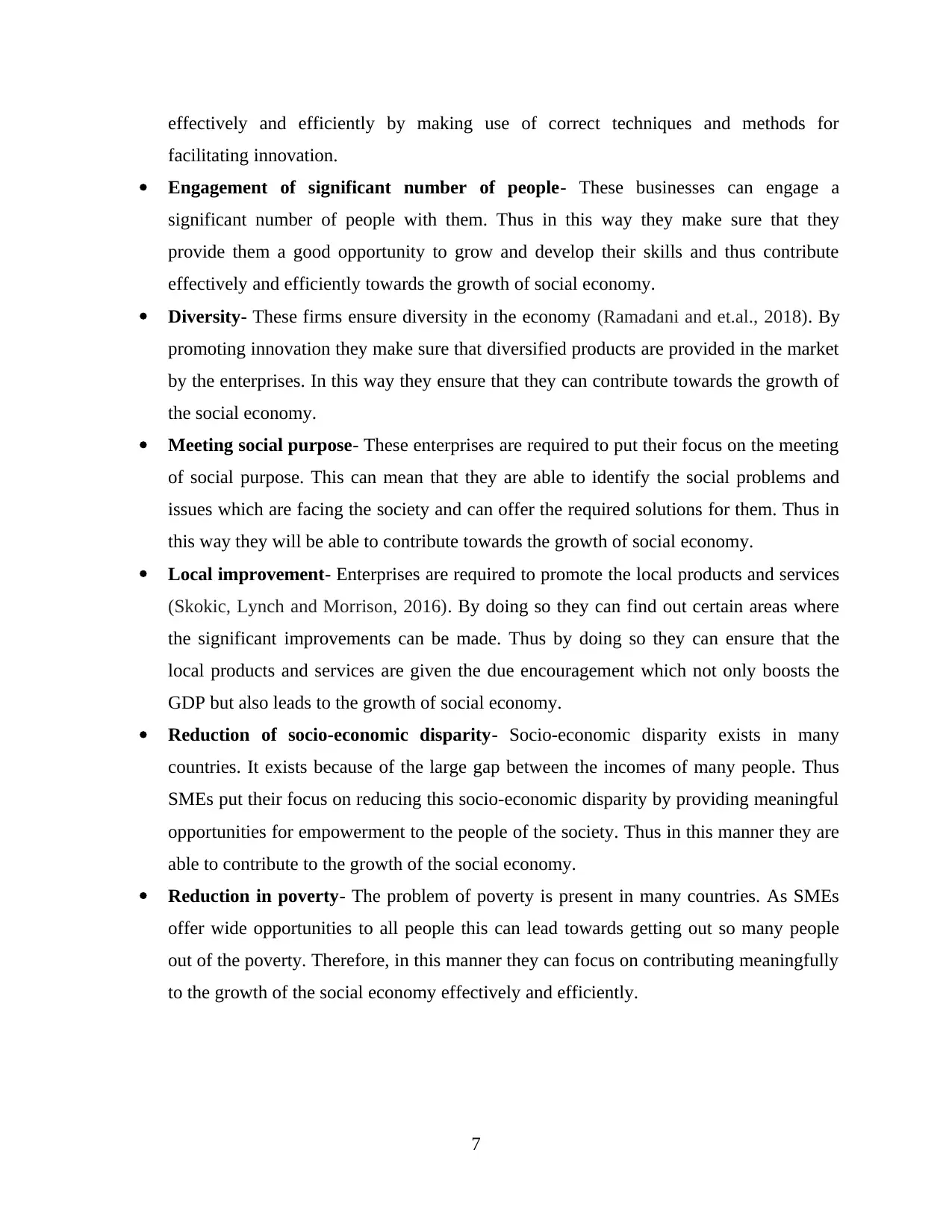
effectively and efficiently by making use of correct techniques and methods for
facilitating innovation.
Engagement of significant number of people- These businesses can engage a
significant number of people with them. Thus in this way they make sure that they
provide them a good opportunity to grow and develop their skills and thus contribute
effectively and efficiently towards the growth of social economy.
Diversity- These firms ensure diversity in the economy (Ramadani and et.al., 2018). By
promoting innovation they make sure that diversified products are provided in the market
by the enterprises. In this way they ensure that they can contribute towards the growth of
the social economy.
Meeting social purpose- These enterprises are required to put their focus on the meeting
of social purpose. This can mean that they are able to identify the social problems and
issues which are facing the society and can offer the required solutions for them. Thus in
this way they will be able to contribute towards the growth of social economy.
Local improvement- Enterprises are required to promote the local products and services
(Skokic, Lynch and Morrison, 2016). By doing so they can find out certain areas where
the significant improvements can be made. Thus by doing so they can ensure that the
local products and services are given the due encouragement which not only boosts the
GDP but also leads to the growth of social economy.
Reduction of socio-economic disparity- Socio-economic disparity exists in many
countries. It exists because of the large gap between the incomes of many people. Thus
SMEs put their focus on reducing this socio-economic disparity by providing meaningful
opportunities for empowerment to the people of the society. Thus in this manner they are
able to contribute to the growth of the social economy.
Reduction in poverty- The problem of poverty is present in many countries. As SMEs
offer wide opportunities to all people this can lead towards getting out so many people
out of the poverty. Therefore, in this manner they can focus on contributing meaningfully
to the growth of the social economy effectively and efficiently.
7
facilitating innovation.
Engagement of significant number of people- These businesses can engage a
significant number of people with them. Thus in this way they make sure that they
provide them a good opportunity to grow and develop their skills and thus contribute
effectively and efficiently towards the growth of social economy.
Diversity- These firms ensure diversity in the economy (Ramadani and et.al., 2018). By
promoting innovation they make sure that diversified products are provided in the market
by the enterprises. In this way they ensure that they can contribute towards the growth of
the social economy.
Meeting social purpose- These enterprises are required to put their focus on the meeting
of social purpose. This can mean that they are able to identify the social problems and
issues which are facing the society and can offer the required solutions for them. Thus in
this way they will be able to contribute towards the growth of social economy.
Local improvement- Enterprises are required to promote the local products and services
(Skokic, Lynch and Morrison, 2016). By doing so they can find out certain areas where
the significant improvements can be made. Thus by doing so they can ensure that the
local products and services are given the due encouragement which not only boosts the
GDP but also leads to the growth of social economy.
Reduction of socio-economic disparity- Socio-economic disparity exists in many
countries. It exists because of the large gap between the incomes of many people. Thus
SMEs put their focus on reducing this socio-economic disparity by providing meaningful
opportunities for empowerment to the people of the society. Thus in this manner they are
able to contribute to the growth of the social economy.
Reduction in poverty- The problem of poverty is present in many countries. As SMEs
offer wide opportunities to all people this can lead towards getting out so many people
out of the poverty. Therefore, in this manner they can focus on contributing meaningfully
to the growth of the social economy effectively and efficiently.
7
⊘ This is a preview!⊘
Do you want full access?
Subscribe today to unlock all pages.

Trusted by 1+ million students worldwide

Brochure
8
8
Paraphrase This Document
Need a fresh take? Get an instant paraphrase of this document with our AI Paraphraser

9

10
⊘ This is a preview!⊘
Do you want full access?
Subscribe today to unlock all pages.

Trusted by 1+ million students worldwide
1 out of 20
Related Documents
Your All-in-One AI-Powered Toolkit for Academic Success.
+13062052269
info@desklib.com
Available 24*7 on WhatsApp / Email
![[object Object]](/_next/static/media/star-bottom.7253800d.svg)
Unlock your academic potential
Copyright © 2020–2025 A2Z Services. All Rights Reserved. Developed and managed by ZUCOL.


